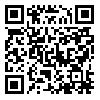1. [1] D. Kragic, and H. Christensen, "Survey on Visual Servoing for Manipulation," Computational Vision and Active Perception Laboratory, Fiskartorpsv 15 ,2002.
2. [2] F. Nadi, "Visual Servoing Control of Robot Manipulator with Jacobian Matrix Estimation, " (in Persian) M.S. Thesis, Faculty of Electrical and Computer Engineering, Yazd University 2014.
3. [3] P. Goncalves, L. Mendonca, J. Sousaand, and J. Pinto, "Uncalibrated Eye-to-Hand Visual Servoing Using Inverse Fuzzy Models," IEEE Transactions on Fuzzy Systems, pp. 341–353, 2008.
4. [4] C. Distante, A. Anglani, and F. Taurisano, "Target Reaching by Using Visual Information and Q-learning Controllers," Autonomous Robots, vol. 9, pp. 41–50, 2000.
5. [5] A. Anglani, F. Taurisano, R. De Giuseppe, C. Distante, and L. Lecce, "Learning to Grasp by Using Visual Information Robot System and Controller Architecture," Autonomous Robots, vol. 9, pp. 41–50, 2000.
6. [6] M. Sadeghzadeh, "Self-Learning Visual Servoing of Robot Manipulator Using Explanation-Based Fuzzy Neural Networks and Q-Learning," Ph.D. Dissertation, University of Guelph, 2014.
7. [7] K. Shibata, M. Sugisaka, and K. Ito, "Hand Reaching Movement Acquired Through Reinforcement Learning," in Proceedings of 2000 KACC (Korea Automatic Control Conference), 2000.
8. [8] Z. Miljkovic, M. Mitic, M. Lazarevic, and B. Babic, "Neural Network Reinforcement Learning for Visual Control of Robot Manipulators," Expert Systems with Applications, vol. 40, pp. 1721–1736, 2013.
9. [9] M. Deisenroth, C. Rasmussen, and D. Fox, "Learning to Control a Low-Cost Manipulator Using Data-Efficient Reinforcement Learning," International Conference on Robotics: Science & Systems, pp. 57–64, 2011.
10. [10] Robotic Arms. (n.d.). Pishrorobot. [Online]. Available:http://www.pishrobot.com/en/products/robotic_arms.htm. Accessed 19 Aug 2016.
11. [11] Kinect | Xbox 360. Xbox.com. (n.d.). [Online]. Available: http://www.xbox.com/en-US/xbox-360/accessories/kinect. Accessed 19 Aug 2016.
12. [12] J. Jang, C. Sun, and E. Mizutani, Neuro-fuzzy and Soft Computing. Upper Saddle River, NJ: Prentice Hall, 1997.
13. [13] S. Guillaume. "Designing Fuzzy Inference Systems from Data: An Interpretability-Oriented Review." IEEE Transactions on fuzzy systems, pp. 426-443, 2001.
14. [14] R. S. Sutton and A. G. Barto, "Introduction to Reinforcement Learning," IEEE Transactions on Robotics and Automation, MIT Press, 1998.
15. [15] L. P. Kaelbling, M. L. Littman, and A. W. Moore, "Reinforcement Learning: A survey," Journal of Artificial Intelligence Research, vol. 1, no. 1, pp. 237– 285, 1996.
16. [16] R. Sutton, and A. G. Barto, "Reinforcement learning," Journal of Cognitive Neuroscience, vol. 11, no. 1, pp. 126-134, 1999.
17. [17] X. S. Wang, Y. H. Cheng, and J. Q. Yi "A Fuzzy Actor–Critic Reinforcement Learning Network," Journal of Information Sciences, vol. 177, pp. 3764– 3781, 2007.
18. [18] L. X. Wang, (1997): A course in fuzzy systems and control. 1. Aufl. Upper Saddle River, NJ: Prentice Hall PTR.
19. [19] R. Babuska, Fuzzy Modeling for Control. Boston, MA: Kluwer Academic, 1998.
20. [20] FJ. Chang, and YT. Chang. "Adaptive Neuro-Fuzzy Inference System for Prediction of Water Level in Reservoir." Advances in Water Resources. pp. 1-10, 2006.
21. [21] Fuzzy hybrid control of robot with camera, aparat, 2016. [Online]. Available: http://www.aparat.com/v/5UWeh. Accessed: 08 Jul 2016.
22. [22] Fuzzy adaptive control of robot with camera, aparat, 2016. [Online]. Available: http://www.aparat.com/v/blqN0. Accessed: 17 Oct 2016.








